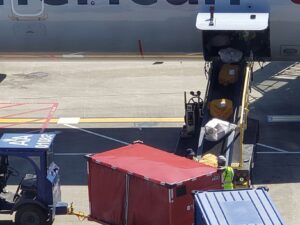Question:
Hi, Daniel, we have an IATA question for you.
|
Note: Note: IATA is the International Air Transport Association. It’s Dangerous Goods Regulations – updated annually – contain all of the requirements of the International Civil Aviation Organization’s (ICAO) Technical Instructions for the Safe Transport of Dangerous Goods by Air. It is applicable to all airlines that are members of IATA and “all shippers and their agents that offer consignments of dangerous goods to these operators.” If you offer a hazardous material for transport by air, you will likely have to comply with the IATA DGR. |
When we have multiple identical overpacks of the same dangerous good, could we put on the declaration “A1 through A33” instead of listing each A1, A2, etc.?
I think we cannot, but wanted verification. But if we can- it would simplify our warehouse manager’s life.
Thank you!
My reply:
Yes you can. Please see below for a more thorough answer.
- To facilitate identification, loading, and notification, the operator requires an overpack to show an identification mark (which may be any alpha-numeric format) and the total quantity of dangerous goods. This information must also be entered on the Declaration. The total quantity of the Declaration must match the total quantities shown on the overpack.
- Step 7 of 8.1.6.9.2 describes the requirements for completing the second sequence of the Shipper’s Declaration for Dangerous Goods: Number and Type of Packagings, Quantity of Dangerous Goods when dangerous goods are packed in an overpack – or multiple overpacks.
- Step 7 of 8.1.6.9.2 does not address your situation directly. It does refer to Figure 8.1.N Example 10 which does.
- Figure 8.1.N Example 10 displays a situation of four (4) overpacks with identical contents. On the Declaration it is described as follows:
- So, it is acceptable to display the overpack identification marks as a range instead of displaying each identification mark separately.
- Also, it is not necessary to display “Marine Pollutant” on the Declaration unless it is a bulk packaging.
- The IATA Dangerous Goods Regulations do not require any additional description for a marine pollutant.
- USDOT/PHMSA Hazardous Materials Regulations require an additional description for a marine pollutant transported by air but only if in a bulk packaging. Since the dangerous good is not in a bulk packaging, it does not require any additional description on the Declaration.
I hope this helps. Please contact me with any other questions.
|
Contact me with any questions you may have about the transportation of hazardous materials by air, highway, vessel, or rail International and Domestic Daniels Training Services, Inc. 815.821.1550 |
Conclusion:
And that did it! If you are offering a package of a dangerous good to be transported by aircraft you must comply with the IATA Dangerous Goods Regulations (be sure you have the latest Edition!). Also, if the air transport begins and/or ends in the U.S. you must also comply with the USDOT/PHMSA Hazardous Materials Regulations (updated every six months!) Both of these regulations require that you provide training for any personnel with a direct effect on the safe transportation of the dangerous good. Let me help you to meet these training requirements!


